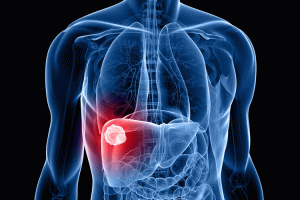
New insights into the journey from health to disease in the human liver have been made by scientists at the Wellcome Sanger Institute, Cancer Research UK Cambridge Institute, the University of Cambridge and their collaborators.
In the largest study of its kind, the team documented in unprecedented detail how the accumulation of changes in our DNA over time, known as mutations, evolves during the development of chronic liver disease and liver cancer.
Researchers discovered that these signatures of DNA mutations are also present in healthy and diseased liver, and that it is the accumulation of changes from these signatures that ultimately leads to serious health problems.
The study, published in Nature, is the largest study of the differences in genetic changes between healthy and diseased liver tissue, with a view to better understanding how liver disease and hepatocellular carcinoma (HCC) develop.
These discoveries advance the possibility of one day using genomic data to predict the future risk of cancer in people suffering from chronic liver disease.
Chronic liver disease, which refers to conditions including cirrhosis, fatty liver disease and cancer, has risen by 400 per cent in the UK since 1970 to become the biggest cause of death among 35-49 year olds.
The commonest causes in the UK are excessive alcohol intake and obesity.
In 2016/17, almost 15,000 deaths were caused by liver disease in the UK.
There has been a 162 per cent increase in cases of liver cancer in the UK since the 1990s, with around 5,900 new cases every year, and by 2035 the number of cases is predicted to rise by 38 per cent (from 2014 levels).
The most common type of primary liver cancer is called hepatocellular carcinoma (HCC).
HCC is rare in people with a normal liver, but commonly develops in people with chronic liver disease.
DNA mutations play a prominent role in many forms of cancer and can be caused by a large number of factors, including genetic factors and things we are exposed to during life such as chemicals found in food or the environment.
Liver cancer arises from the effects of particular types of DNA damage, which cause specific signatures of mutations.
The common genetic events and patterns of DNA mutation associated with liver cancers were previously known, but it was unknown in what order these events occur, or why some people with chronic liver disease develop cancer but others develop failure of the liver to perform its normal function.
The new study is the most comprehensive use of genomic analysis to compare normal liver tissue with tissue affected by chronic liver disease, providing researchers with an unprecedented level of detail on how the accumulation of DNA mutations over time leads to liver disease and cancer.
Tissue samples from five normal and nine cirrhotic livers were collected by Addenbrooke's hospital in Cambridge.
From these samples, scientists at the Wellcome Sanger Institute created 482 whole genome sequences so the DNA of the tissues could be analysed.
The team observed a substantial increase in the number of mutations in chronic liver disease compared to normal liver.
Cirrhotic liver tissue contained around twice the number of mutations as healthy liver and HCC tumour tissue had an even higher numbers of mutations.
The variety in the type of mutations in diseased and cancerous tissue was also much greater than healthy liver, with mutations causing more damage to the overall integrity of the DNA.
Only a few mutations associated with HCC were discovered in the chronically diseased liver, suggesting that the increased risk of liver cancer arises because the substantial DNA damage seen in liver disease promotes the emergence of cells with the potential to eventually become cancers.
The study also highlighted the way our environment can influence the patterns of DNA damage in the liver.
For example, 10-20 per cent of DNA mutations in samples from one patient indicated exposure to a toxin produced by Aspergillus moulds.
These moulds often contaminate crops and are prevalent in arable farmers, which was the occupation of the patient.
The researchers say that many things can cause DNA mutations associated with cancer, particularly in the liver because it processes many of the chemicals that we are exposed to in our diet and the environment.
As such, the richest diversity of DNA mutations are found in liver cancer.
Dr Matthew Hoare, a lead author of the study from the Cancer Research UK Cambridge Institute, said: "It's incredibly compelling to be able to show how liver disease affects the DNA in our livers. We knew there was a link between chronic liver disease and liver cancer, so it was unexpected to find so few cancer-causing mutations among the DNA damage in liver disease. The next step will be to look for common patterns within this damage that might help us predict who is at a higher risk of cancer".
People with chronic liver disease have a higher risk of HCC, but it is not clear why this cancer occurs in some of these people and not in others.
For now the exact cause of HCC remains unknown, but understanding that the processes involved in chronic liver disease are the same as those involved in HCC opens up the possibility of one day being able to predict an individual's risk of liver cancer.
Dr Peter Campbell, a lead author of the study and Senior Group Leader at the Wellcome Sanger Institute, said: "What's interesting about the findings of this study is that we have been able to observe how excessive alcohol intake and obesity are linked to DNA mutations in chronic liver disease as well as liver cancer. Though it is early days, we can start thinking about ways to predict a person's risk of liver cancer from the number and types of mutations in their DNA."
Source: Wellcome Trust Sanger Institute